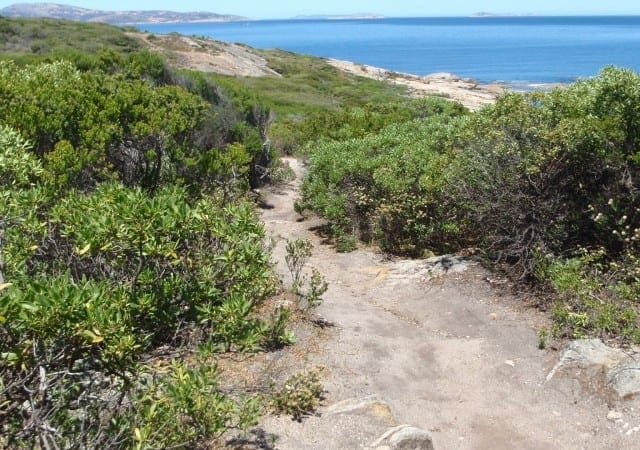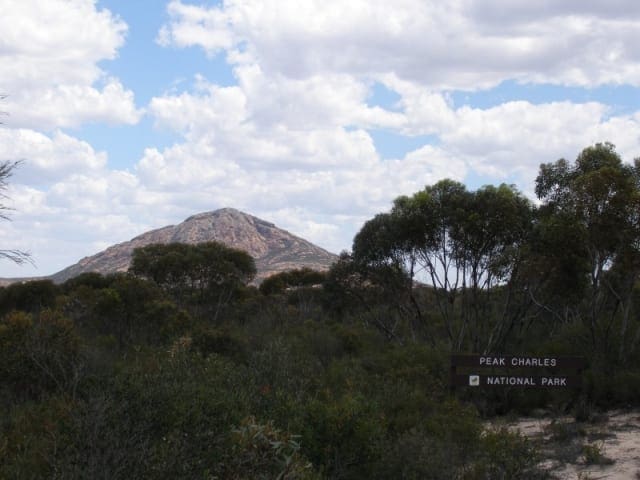Tagon Coastal Trail is a 14 kilometre return moderately difficult walk in Cape Arid National Park. The Tagon Coastal Trail winds through coastal heath and across rocky headlands, providing excellent vantage points for whale watching.
Tagon Coastal Trail starts at the eastern end of Yokinup Bay at the mouth of the Thomas River. Depending on the time of year and if the river is broken through to the ocean, walkers may have to wade through the river to access the start of the walk from the Picnic Area Car Park. A great location to spot a number of different Bird species including Hooded Plovers, Crested Terns and Oyster Catchers. The trail offers spectacular views of the coastline and a great vantage point for watching migatory whales (July- October). The walk takes you up a moderately steep incline over exposed granite around a number of headlands traversing through coastal heath where emus can be spotted. The trail can be sandy with granite outcrops to cross and is unmarked apart from where the vegetation has been trimmed to delineate the path or the occasional wooden marker peg across the granite outcrop. Where the trail follows the beach it is unmarked and walkers should follow the tide line. Walk trail surface consists of natural pavements made up of rock material including exposed granite, gravel and beach sand. Some parts of the track may be eroded after heavy rain.
Start Point: Western end of Yokinup Bay, Cape Arid National Park 125km (1.5 hours) east of Esperance
End Point: Western end of Yokinup Bay, Cape Arid National Park 125km (1.5 hours) east of Esperance
Region: Cape Arid National Park, Golden Outback
For more information, a location map and GPS file please visit Trails WA.
Got some great shots from this hike? Upload your photos here to inspire others and show off the beauty of the trail!
Submitting your photos doesn’t mean you lose ownership. You can be credited for your contributions, and you can request removal at any time.
Please don’t copy GPX files or content from this site to AllTrails or other platforms. Each trail has been personally mapped, documented, and refined to support Australia’s bushwalking and hiking community. While some details come from land managers, every listing reflects significant personal effort. This is a free, community-driven initiative—your respect helps keep it that way.
It looks like I don’t have a GPX file for this trail yet. If you have one to share, please email it to me! I’ll verify it against official maps before adding it to help other hikers have a safer, easier experience. Thanks for contributing to a better hiking resource.
Getting there
Getting to the trailhead: Cape Arid National Park.
Closest towns to this walk: Cape Le Grand, Condingup, Esperance, Munglinup, Nornalup, Ravensthorpe, Salmon Gums, Salmon Gums Balladonia, Scaddan Balladonia
About the region
Cape Arid National Park is a wildly beautiful and biodiverse area. Coastal sandheaths, mallee and low granite hills extend inland to Mount Ragged after which the vegetation is transformed into woodlands dominated by saltbush and bluebush. The jagged Russell Range, which rises to its highest point at Tower Peak (almost 600m), comprises ancient uplifted quartzite that has the same origins as the Barrens Range in Fitzgerald River National Park.
Similar walks nearby
Looking for more walks in or near Cape Arid National Park? Try these trails with a similar difficulty grade.
Favourite

Cape Le Grand National Park
Favourite

Woody Island Nature Reserve
Favourite

Peak Charles National Park
Favourite

Track grade
Grade 4 (Hard) -
Challenging Walks for Experienced Walkers: Grade 4 on the
AWTGS signifies challenging walking tracks. Bushwalking experience is recommended for these tracks, which may be long, rough, and very steep. Directional signage may be limited, requiring a good sense of navigation. These walks are suited for experienced walkers who are comfortable with steeper inclines, rougher terrain, and potentially longer distances.
Explore safe
Plan ahead and hike safely! Carry enough water, pack layers for changing conditions, and bring safety gear like a torch, PLB, and reliable communication device. Check official sources for trail updates, closures, and access requirements, and review local weather and bushfire advice. Most importantly, share your plans with someone before you go. Being prepared makes for a safer and more enjoyable hike! Stay Safe, Explore More, and Always #ExploreSafe.
Packing checklists
What you carry in your pack depends on factors like weather, terrain, and your adventure type. Not sure what to bring? My free planning, food, and packing checklists are a great starting point, covering day hikes, overnight trips, and multi-day adventures. Use them to customise your kit and always prioritise safety.
Let someone know
Before heading out, take a moment to fill out your trip intentions form. It’s a quick way to share your hike details with family or friends. If something goes wrong, they can notify emergency services, ensuring a faster response and peace of mind. Stay safe and enjoy your adventure
Suggest an edit
Spotted a change on this trail? Maybe there are new features, the route has shifted, or the trail is permanently closed. Whatever the update, I’d love your input. Your feedback helps fellow hikers stay informed and ensures that our trail info stays fresh and reliable.






